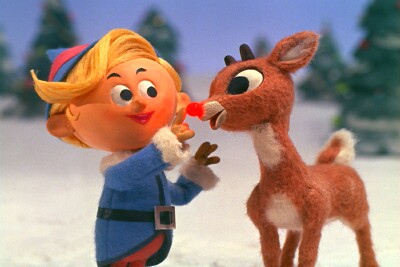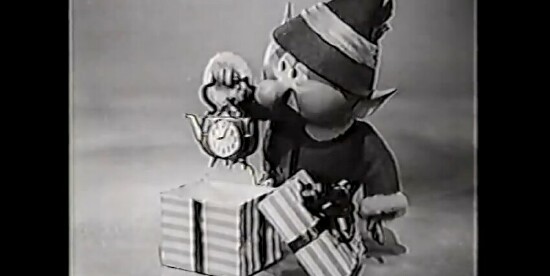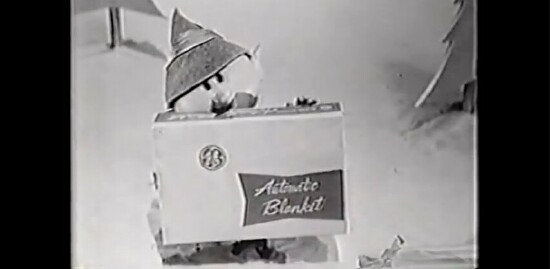Holiday Treasures: The General Electric Commercials Showcased in the Premiere of "Rudolph the Red-Nosed Reindeer" -- Ed Martin

CBS will present its annual telecast of “Rudolph the Red-Nosed Reindeer” tonight, arguably the best holiday television special of all time and certainly one of the most durable.
It will make many readers of this column feel very old indeed to note that “Rudolph” this year will mark its 50th anniversary (though not its 50 th telecast, as CBS some years actually runs it twice during the season). How can it be that a half-century has passed since its premiere on December 6, 1964? And how can it be that, with the exceptions of “A Charlie Brown Christmas” (which premiered on CBS on December 9, 1965) and “Dr. Seuss’ How the Grinch Stole Christmas!” (first seen on CBS on December 18, 1966) there hasn’t been another holiday season special since “Rudolph” that has become a genuine annual tradition? (Somehow I don’t think NBC’s “How Murray Saved Christmas,” which made its premiere this past Friday, is going to hold up. (If you want to include on that shamefully small list “Frosty the Snowman,” which premiered on CBS on December 7, 1969, please feel free to do so. “Frosty” never worked for me. It’s a matter of personal taste. But I understand Frosty has a vocal fan base and I don’t want to compromise anyone’s holiday joy.)
Fifty years later certain interesting aspects of the very first telecast of “Rudolph” have been long forgotten, likely because much of the adult audience that enjoyed it that night is no longer with us or too old to remember much of anything. Did you know that it was presented in 1964 by General Electric as part of The General Electric Fantasy Hour? Or that it was first seen on NBC? (The Peacock would run it every year through 1971; in 1972 CBS wisely acquired it and has run it ever since.)
Many advertisers have flocked to the annual telecasts of “Rudolph” over the years, but they couldn’t be a part of the original presentation, because it served as an exclusive showcase for commercials promoting small General Electric appliances. Some of the spots featured the elves from Santa’s workshop in “Rudolph.” (In the image below the elves have spelled out “GE” in wrapped gifts. General Electric’s spanking-new coffee pot of the day can be seen near the bottom of the “G.”)
There is an excellent compilation of the GE commercials that ran throughout the original telecast on YouTube. (Click on any of the images in this column to watch it.) Viewed today they appear to be transmissions from another dimension in prehistoric black and white and geared largely to young suburban housewives who were busy making the perfect home for their families.
Electric knives, electric toothbrushes, electric blankets, electric wall clocks, can openers and vacuum cleaners were among the new household must-haves of the day. These commercials may look as old as the mountains, but they have an undeniable charm, and the music and animation throughout make them almost as entertaining as “Rudolph” itself. This may be the best example ever of commercial content fitting seamlessly and yet unobtrusively into the presentation of a television program.
I’ve been a big a fan of “Rudolph” since I first saw it in the Sixties. I remember how excited my brother and I would get when the opportunity to watch it drew near. I remember the urgency of it all: We had to be in front of our (black and white) TV set when it was on, lest we miss a minute of our only opportunity to see it that year. And I remember the sadness that followed when “Rudolph” ended, because we would have to wait another 12 months to see it again! Perhaps that’s the reason why “Rudolph” still feels like a special that has to be watched when it is actually on, rather than at my convenience via DVR or DVD.
The now priceless General Electric commercials aren’t the only unique content from the first telecast of “Rudolph.” Did you know it featured an ending different from the one we have all come to know, in which Rudolph reneged on his promise to return with Santa to the Island of Misfit Toys and rescue his hopeless little friends from their lonely existence? That’s right – Charlie in the Box, the Spotted Elephant, Dolly and the rest were forgotten and left to shiver in the snow! Following that telecast there was such an outcry from traumatized children everywhere that the ending was quickly remade into the one we have known forever, with the misfits happily scooped up and delivered to little girls and boys on Christmas Eve, as it should be.
Also at the end of that original 1964 telecast, Yukon Cornelius discovered a Peppermint Mine near Santa’s workshop. (That explains why he always licks his pick-axe every time he tosses it – he’s hoping to taste peppermint!) That scene was cut to make room for the rescue of the misfit toys and has never been seen again.
Ed Martin is the Editor of MediaBizBloggers and the television and video critic for the Myers Business Network. Follow him on Twitter at @PlanetEd.
Business Network. Follow him on Twitter at @PlanetEd.
Check us out on Facebook at MediaBizBloggers.com
Follow our Twitter updates at @MediaBizBlogger
The opinions and points of view expressed in this commentary are exclusively the views of the author and do not necessarily represent the views of MediaBizBloggers.com management or associated bloggers. MediaBizBloggers is an open thought leadership platform and readers may share their comments and opinions in response to all commentaries.





